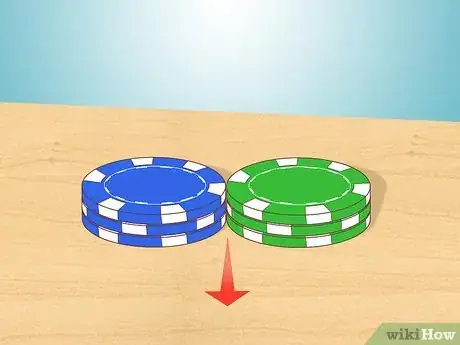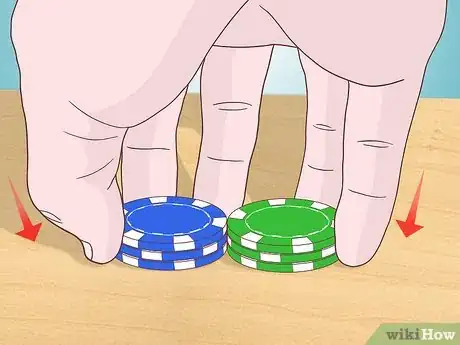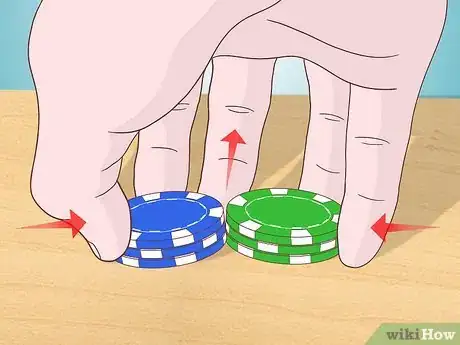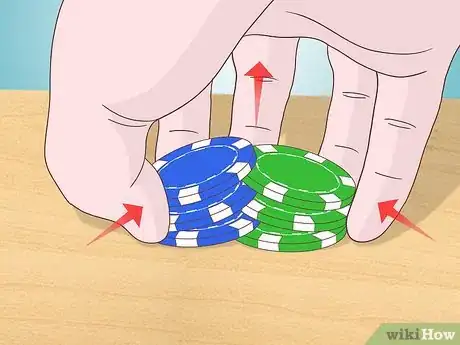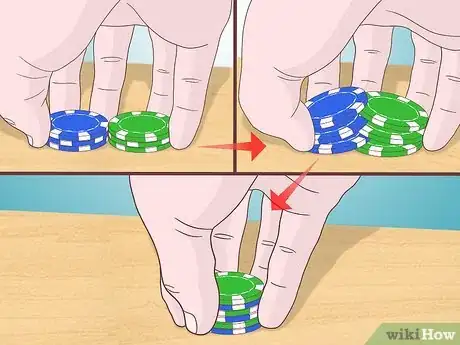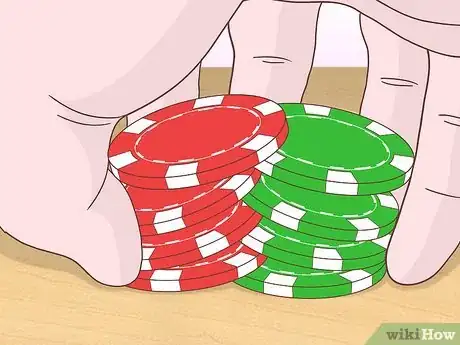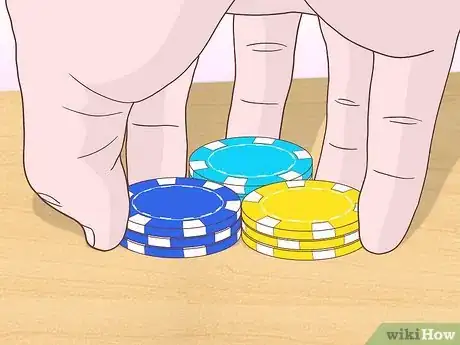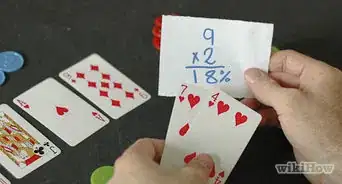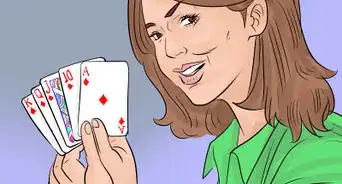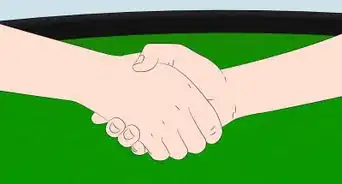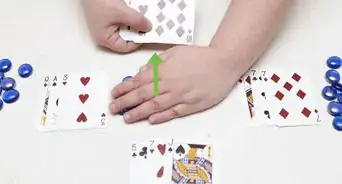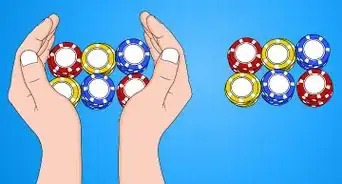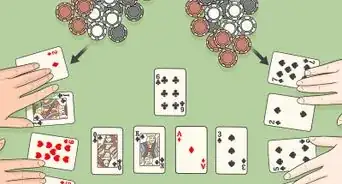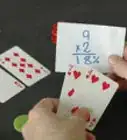This article was co-authored by wikiHow Staff. Our trained team of editors and researchers validate articles for accuracy and comprehensiveness. wikiHow's Content Management Team carefully monitors the work from our editorial staff to ensure that each article is backed by trusted research and meets our high quality standards.
There are 7 references cited in this article, which can be found at the bottom of the page.
This article has been viewed 146,708 times.
Learn more...
If you play poker or have watched professional poker tournaments, you may have noticed that many players will "shuffle" their chips. Players may do this to help them better concentrate or to simply help pass the time. While chip shuffling may look impressive, it's actually very easy to learn.
Steps
Doing a Basic Shuffle
-
1Start out with six chips. Shuffling is easier with a smaller number of chips, and six is the minimum amount needed.[1] It will be helpful if you pick three chips of one color and three chips of another.
- If you don't own any poker chips, you can practice with six coins of equal size instead. While the shuffling method will be the same, coins are a little more difficult to work with.[2]
-
2Divide the chips into two stacks of three each. Separate the chips by color. The different colors will help you to distinguish between the two different stacks. If you shuffle correctly, you will end with one stack of alternating colors.Advertisement
-
3Place the two stacks on a flat surface in front of you. Position them parallel to you. Shuffling will be easier to do on a soft surface. Consider practicing on a bed, pillow, couch, or some felt at first. As your shuffling skills improve, you can switch to a hard surface.
-
4Position your dominant hand over the chips. Your hand should be roughly parallel with the flat surface, while your fingers should point face down, touching it at their tips. Your thumb and index finger should be up against opposite sides of one stack with your thumb closer to your body. Your pinky and ring fingers should be up against the other stack. Place your middle finger between the two stacks at the side further from your body.[3]
-
5Push the two stacks together while pulling your fingers up. Apply slight pressure to the two stacks with your thumb, index finger, ring finger, and pinky. Hook your middle finger so that its tip is slightly under the two stacks at the center. Pull up with your middle finger and then let the two stacks fall back down. Squeeze your fingers while doing this so that the stacks come together.[4]
-
6Guide the chips with your middle finger. Run your middle finger along the two stacks as they fall back down. Use your middle finger to control how the chips fall, alternating the two stacks perfectly. Once they have been laced together, complete the shuffle by squeezing your hand completely, creating a single stack with six chips.[5]
-
7Split the stack and do everything again. Lift the top three chips off of the tall stack between your thumb and middle finger. Place these chips next to the bottom three, creating two stacks of three like you started with. Shuffle again, split, and repeat until you are able to do everything in one fluid motion.
Troubleshooting Issues
-
1Look at the chip pattern for clues. One reason why it's a good idea to practice with different colored chips is that it makes it easier to tell when something is going wrong with your shuffle. When done properly, your shuffled chips should alternate between the two colors. If you see two or more of the same color next to each other in the stack, you should reevaluate your technique. If there is a general lack of interlacing, you can try working on couple aspects of your shuffle:
- Make sure you aren't shoving the two stacks together. You should only exert a minimal amount of force when pushing from the sides while the chips are falling.
- You may not be lifting the two columns correctly. The bottom chips should form 45 degree angles with the table.[6] A slightly wider angle will also work, but a more acute one will not give the chips room enough to fall.
-
2Experiment with finger placement. While the standard shuffle grip works for both right- and left-handed people, it may not work best for everyone.[7] You can place your fingers however you like, as long as the position fulfills two major requirements: You must have at least one digit on the far outside edge of each stack so that they can be pushed together. Additionally, one digit must be able to hook underneath where the two stacks meet.
- It's normal to experience some discomfort in your hand when you first start to shuffle since you may be using muscles in ways you're not used to.[8] However, if you continue to feel uncomfortable after practicing, consider modifying your finger placement.
-
3Ask someone to watch or record your shuffle. When you're shuffling poker chips, it can be difficult to see what's going on since your hand will be blocking your view. Someone else closely watching you shuffle can help you figure out the exact step you're having trouble with.
- Even better, ask him or her to make a close-up video of you shuffling. Watch the video for yourself in slow motion, paying close attention to the position of the chips and your hand motions. Observing your actions from the outside can give you a better perspective.
Improving Your Skills
-
1Add more chips. Once you can confidently shuffle six poker chips, add two more chips and practice shuffling eight together. Once you get comfortable with eight, try ten. Keep adding chips in increments of two.[9] The only limiting factor to the number of chips you can shuffle will be the size of your hands.
-
2Practice with the maximum number of chips you can handle. Shuffling a large stack of chips is more difficult than working with a small one. However, you will use the same muscles and movements shuffling both. By practicing with a larger number of chips, you will be sure to shuffle a slightly smaller number with ease during an actual game.
-
3Try adding a third stack. Shuffling three stacks is fundamentally similar to shuffling two stacks but is much more difficult to accomplish. Even people with a lot of poker chip trick experience have difficulty with the triple stack shuffle. If you'd like to give it a try, the method itself is deceptively simple:
- Make a triangle out of three equal stacks of at least three chips.
- Press the fingers of your dominant hand vertically against the three stacks. Your thumb will hold one stack, your index and middle fingers a second, and your ring finger and pinky the final third.
- Push the three stacks into each other.
- While pushing, lift your hand up.
- While pushing and lifting your hand, try to tilt all three stacks upwards at the center of the triangle.
- Squeeze the three stacks together with your fingers.[10]
References
- ↑ https://www.youtube.com/watch?v=pwfvsa1_3Qk
- ↑ http://www.coinmanipulation.com/Coin/Tricks/Shuffle_TwoStack.html
- ↑ http://www.coinmanipulation.com/Coin/Tricks/Shuffle_TwoStack.html
- ↑ http://www.talkingpoker.com/chiptricks.htm
- ↑ http://www.coinmanipulation.com/Coin/Tricks/Shuffle_TwoStack.html
- ↑ http://www.talkingpoker.com/chiptricks.htm
- ↑ http://www.coinmanipulation.com/Coin/Tricks/Shuffle_TwoStack.html
- ↑ https://www.youtube.com/watch?v=pwfvsa1_3Qk
- ↑ https://www.youtube.com/watch?v=pwfvsa1_3Qk
About This Article
To shuffle poker chips, start with 6 chips divided into 2 stacks of 3. Then, with the 2 stacks next to each other on a flat surface, place your fingers down on the table and around the chips. Position your thumb and index finger so they're on opposite sides of one stack, and do the same with your pinky and ring finger. Next, push the 2 stacks together while lifting up on the chips with your middle finger so the chips lace together and form a stack of 6. When you're finished, split the stack and repeat. To learn how to shuffle 3 stacks of poker chips, scroll down!


